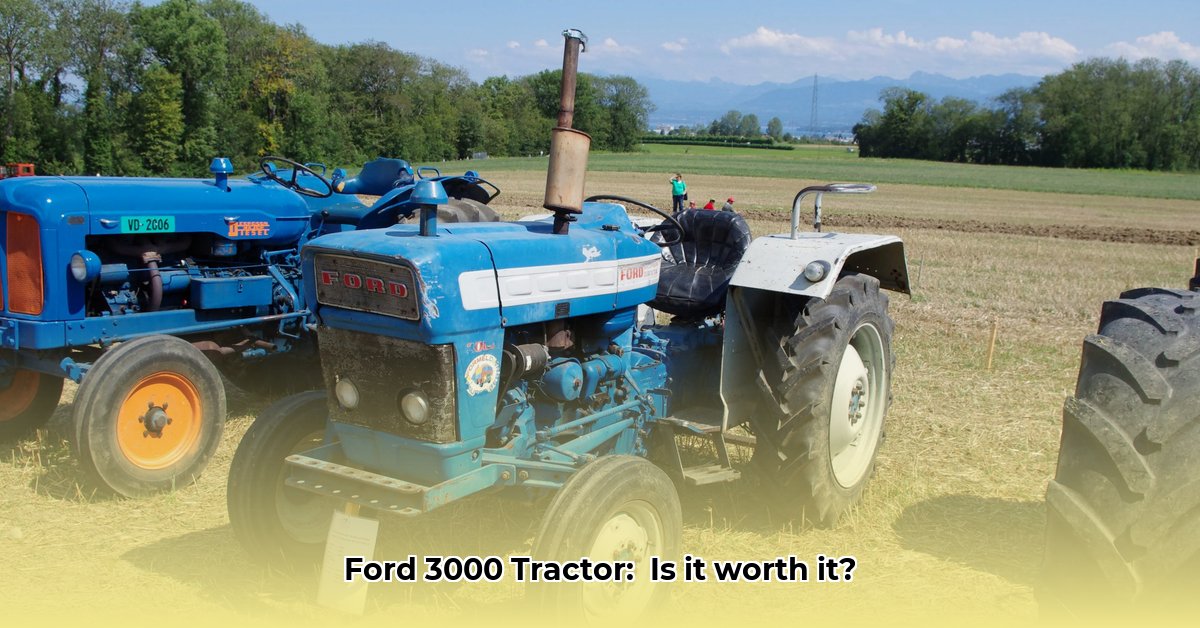
3000 Ford Tractor: Your Guide to Buying and Pricing
The Ford 3000 tractor, produced from 1964 to 1981, remains a popular choice among farmers and collectors. Its enduring appeal stems from its robust build, relative ease of maintenance, and generally good parts availability. However, navigating the used market requires careful consideration of several factors to ensure a worthwhile investment. For more information on similar Ford tractors, check out this helpful resource: Ford Tractor Data.
What Makes a Ford 3000 Tractor Worth More?
The price of a used Ford 3000 varies significantly. Several key factors determine its value:
- Condition: A well-maintained tractor is worth considerably more. Lower operating hours indicate less wear and tear.
- Engine Type: Diesel engines are generally preferred over gasoline engines due to their increased power and longevity, commanding higher prices.
- Transmission: Tractors with more gears (e.g., 6-speed, 8-speed, 10-speed, or 12-speed) offer greater versatility and thus command higher values.
- Features: Power steering and a front-end loader significantly boost a tractor's value.
- Maintenance History: A complete record of maintenance and repairs adds substantial value, demonstrating responsible ownership.
Isn't it interesting how seemingly small details can have such a significant impact on a used tractor's price? It highlights the importance of a thorough inspection.
How Much Should You Expect to Pay?
Prices for a Ford 3000 typically range from under $3,000 to over $8,000, with many falling between $4,000 and $6,000. However, location and regional demand influence pricing. These figures are estimates; thorough research is essential before purchasing. Remember, a meticulously maintained tractor will always fetch a premium.
Checking Out Your Potential Ford 3000: A Step-by-Step Inspection
A pre-purchase inspection is crucial. Follow these steps:
- Exterior Inspection: Examine for rust, dents, or damage. Check for hydraulic leaks.
- Engine Check: Listen for unusual noises while the engine runs. Inspect belts, hoses, and fluid levels.
- Transmission Test: Shift through all gears; smooth operation is key.
- Hydraulics Test (if applicable): Operate the hydraulic system to ensure functionality.
- Electrical System Test: Check all lights, gauges, and electrical components.
- Review Paperwork: Request service records and the owner's manual for a complete history.
This methodical approach significantly reduces the risk of unexpected issues after purchase.
The Good and the Bad of Owning a Ford 3000 Tractor
Advantages:
- Simplicity: Relatively easy to maintain and repair compared to modern tractors.
- Parts Availability: Parts are generally available, although this can vary regionally.
- Reliability: Ford 3000 tractors have a reputation for durability and reliability.
- Resale Value: They tend to retain a relatively stable resale value.
Disadvantages:
- Age: Expect some wear and tear; major repairs can be costly.
- Parts Availability: Finding specific parts might be challenging in certain locations.
- Fuel Efficiency: Fuel economy is lower compared to newer models.
Is a Ford 3000 Tractor Right for You?
A Ford 3000 is ideal for collectors or small farmers needing a reliable workhorse. However, carefully weigh the costs and risks. Consider restoration costs, which can be significant depending on the tractor's condition. Ultimately, your needs and budget will determine if a Ford 3000 is the right choice. How much time and money are you willing to invest?
Understanding the Potential Risks
| Component | Potential Problem | Mitigation Strategies |
|---|---|---|
| Engine | Parts Availability | Secure a reliable parts supplier; establish relationships with mechanics. |
| Transmission | Wear and Tear | Regular maintenance; consider rebuilding as needed. |
| Hydraulic System | Leaks or Failures | Regular inspection and prompt leak repair. |
| Electrical System | Wiring Problems | Regular inspection and timely part replacement. |
| Body/Paint | Rust and Corrosion | Preventative maintenance; professional restoration as needed. |
How to Determine Fair Market Value for a Ford 3000 Tractor
Key Takeaways:
- Accurate pricing requires analyzing factors beyond age.
- Online tools provide initial estimates; professional appraisals are crucial for high-value sales.
- Condition, operating hours, and attachments significantly impact value.
- Regional demand and economic conditions play a role.
- Technological upgrades enhance resale value.
Understanding the Ford 3000's Market Position
The Ford 3000's legacy is undeniable, but determining its fair market value involves more than just its age. Many factors must be considered for accurate valuation.
Key Factors Affecting Value
- Age and Hours: Lower hours and a younger tractor generally fetch a higher price.
- Condition: Excellent condition commands a premium; rust and damage reduce value.
- Horsepower: Higher horsepower models are more valuable.
- Attachments: Included implements increase the tractor's worth.
- Regional Demand: Local market conditions influence pricing.
- Technological Features (if any): Modern additions boost value.
Using Online Resources and Professional Appraisals
Online resources like TractorData.com offer starting points, but professional appraisals are essential for accurate valuation. These provide a much more nuanced view of the tractor's condition and market value.
Step-by-Step Valuation Process
- Gather Information: Document age, hours, condition, horsepower, and attachments.
- Use Online Estimators: Consult various online tools for a price range.
- Thorough Inspection: Assess mechanical issues, rust, and overall condition.
- Compare Listings: Analyze prices of similar tractors sold recently in your region.
- Factor in Regional Demand: Consider local market conditions.
- Professional Appraisal: Consult a qualified appraiser, especially for higher value tractors.
Additional Considerations
- Maintenance Records: Comprehensive service history boosts confidence and value.
- Seasonal Demand: Sales generally increase during planting and harvest seasons.
- Market Trends: Economic conditions influence demand for farm equipment.
[1] TractorData.com